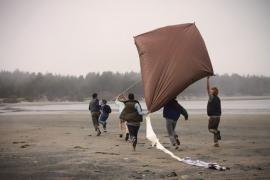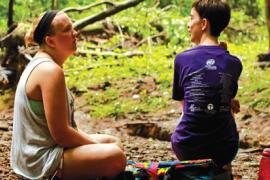In today's tough, competitive environment, it seems the only thing a camp director can be certain of is uncertainty. Everywhere around us, change is occurring — changes that have forced many camp professionals to rethink the way we look at our business in an effort to ensure our own camps remain a viable and relevant experience for children in the year 2020 and beyond. While most of us believe that it will still be vitally important for camps to make an impact on youth for future generations, we should evaluate what we as individual camps are doing to adapt to meet the needs of today's consumers.
Do you remember what some refer to as the "golden days" of camping? Those were the days when parents simply signed up their child for two, four, or eight weeks of camp without asking many questions. Parents rarely, if ever, called, and they viewed your camp as a perfect fit because their child came home happy and had fun. If a parent really wanted a five-day, art camp in Wisconsin and could not find one at a camp fair, they most likely signed up for a similar program that was perhaps a bit longer or shorter, had art as one of the many activities, and was in a state close to Wisconsin.
In stark contrast, today's consumers are increasingly global in nature. Now, consumers have higher expectations, more choices in summer options than ever before, and want to ensure that money spent on programs for their children is well worth it. Today's consumers have information at their fingertips and are defining "camp" more as an experience that comes in many shapes and sizes, and not necessarily the traditional camp setting on a lake with canoes that long-time professionals historically defined as camp. As a result, it is important that camps be comfortable with ambiguity, confident with change, open to discovery, and much more nimble in order to meet the ever-changing needs and desires of today's families. How do we adapt without compromising our core mission or values? How do we adapt while staying true to our current clientele?
Be More Flexible
It seems that within and outside of the camp world, consumers are demanding flexibility. In part, because of all the information about opportunities and experiences that are available to today's youth, parents now have more ability than ever to define "camp" and what it means to and for them. We can either spend time fretting over what is and what is not "camp," or we can accept that the market has changed our definition of camp and focus on being adaptable to meet the needs of today's consumers. This flexibility may come about in a variety of shapes and forms that will continue to evolve.
All of this can be done without compromising your core mission and values. This may mean offering more session options, allowing a family to pick up their son for a baseball tournament in the middle of camp, offering flexible payment plans, taking credit cards for the first time, or allowing a family to enroll without the full deposit.
To many of us, the idea of becoming more flexible with our customers is a path we would prefer not to take. However, we need to remind ourselves that companies who are able to adapt in times of change and uncertainty are the ones who survive. In 1976, there were twenty-one, eight-week-only, independent, for-profit camps in the Mid-west. Today there are not any eight-week-only, independent, for-profit camps in the Mid-west. What happened to the eight-week-only camps? They either adapted to what the market wanted, or they no longer exist.
While camps thrive on tradition, the camps that stay ahead of the curve are able to keep important camp traditions and programs in tact while changing and adapting their offerings to meet the needs of future customers.
Evaluate, Re-evaluate, and Evaluate Again
What was popular in 1970 may not be popular with campers in 2010. Create a list of programs and activities that have declined in interest with some of your current families and campers over the years. Now create a list of things which have not been affected — those you think will stay the same based on what you believe are interests of not only today's camp families, but future families. Finally, create a list of programs for the future. These are programs that you have started to hear campers and parents ask about, but you do not yet offer.
Do an Annual Personal Camp Assessment
In addition to evaluating your program and activities, camps should take time to work with their leadership team and address the following areas at least once a year:
- How can we improve our menu offerings to ensure we are meeting the needs of today's campers?
- Do we know our exact camper retention rate, and if a camper is not returning, do we know why?
- Are we going to change how we use social media to connect with our campers and staff?
- Are we addressing the economic situation that many families are facing today?
- Have we updated photos on our Web site? Do our photos show diversity at our camp?
- How can we improve our PR and marketing materials?
- How can we exceed parent expectations this summer? What can we do that will really "wow" our customers?
- Are we continuing to build authentic relationships with our camp families, or do we find ourselves doing more and more electronically?
- What are we doing to change our staff orientation to address topics that campers and staff face today?
- How are we going to be better this year than we were last year?
Emphasize That Camp Is a Crucial Part of a Child's Education
Camps are gaining recognition as a crucial component to combat summer learning loss. To help educate the public that we are a solution to summer learning loss, we may need to change how we talk about camp. Words such as fun, memories, and life skills are no longer enough for parents. We need to help the external world understand that in addition to the vital life skills we all know campers learn at camp, campers also have an enormous amount of educational opportunities at camp.
Many camps offer the opportunity for campers to learn about cultures from around the world (social studies), provide campers with outdoor education and nature programs (science), teach campers to cook by following recipes (math), require good old letter writing as a means of communication to family and friends (writing), offer a camp newspaper or camp yearbook class (reading, writing, and comprehension). Find ways to articulate to parents what their children are learning while they at camp.
Some traditional camps now have camp book clubs, offer tutoring in core content areas, and have creative writing as an activity to address parent concerns about their children "falling behind" over the summer.
Open Doors to International Populations
The world is getting smaller and smaller. To reach out to this new market, think about translating your Web site into other languages, offer ESL to international campers at no additional cost, employ staff who speak a variety of languages, and take time to learn about the cultures where your campers are coming from.
Reach Out to New Populations of Campers
We cannot expect populations who have not experienced summer camp to come knocking on our door. To actively and intentionally pursue communities where children currently do not attend summer camp, think about sponsoring an educational event at their school, ask if there is an opportunity to speak at a parent night about how camp can help minimize summer learning loss, volunteer to set up a booth at a community-sponsored event, and partner with community leaders and ask them how to most effectively reach out to families in their communities.
Diversify
In his Camping Magazine interview "The Time is Now," published in the January/February 2010 issue, Fred Miller shared that "we are somewhere between thirty and forty years from being a non-majority Caucasian country, and we are in the process of significant change in age, because of extension of life. We are in the last decade of two transitions that have been going on for a very long time." We are no longer becoming a diverse nation, we are one.
Develop intentional recruiting systems for both campers and staff that target diverse populations. For many families, it helps ease the transition to camp by showing that there will be other adult role models who look, talk, and act like their child. Commit to diversity from the top down and start by reaching out to potential staff from diverse backgrounds. Most colleges and universities today have diversity resources and groups on campus. Try to connect with these groups and perhaps volunteer to give presentations to students to help them understand the value of working at a summer camp.
Hold on to Your Core Mission and Values
With all this talk of change, it's easy to lose sight of who you are and why you do what you do. It is important not to confuse change with a change in your mission. Camps who keep true to their core mission while adapting and making changes to meet today's consumers will ultimately be the most successful one hundred years from now.
Change is happening right before us and as much as some of us may want to stop it, the reality is that fighting against it may slow it down or divert it, but it won't stop it. And, ultimately if you are not a leader in change, you may find yourself playing a lot of catch up.
It is important to point out that there are many camps out there today that are very content and successful serving certain populations and markets extremely well. Perhaps these camps may not have to change as much as others because they are serving a niche market and doing an exceptional job serving that market. But, no matter how you judge your camps' success, the most successful leaders know that change is something to embrace and be intentional about.
The silver lining with all of this market change is that regardless of whether or not you feel the need to change, uncertain times force all of us to take a close look at our business model and make sure we are running not only the best camp possible, but one that is relevant to what today's parents and children want. As we celebrate ACA's 100th anniversary this year, we should ask ourselves what we are doing today as camp professionals to ensure our individual camps and our industry continue to play an essential role in youth development for the next one hundred years.
Originally published in the 2010 March/April issue of Camping Magazine.


